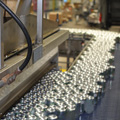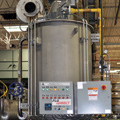
Complete thermal exchange technology
optimizes the bottle warming process on 13 production lines at eight separate
beverage plants. Photos courtesy of Virtual Marketing Consultants.
Of those surveyed in a recent trade publication study of the beverage manufacturing industry, 75% indicate the biggest motivating factor for going green is to achieve cost reductions.
As a result, energy-efficient manufacturing equipment is taking the food and beverage industry by storm.
Uncle Sam also is taking notice by offering tax incentives for reducing energy demand. According to Section 179D of the Internal Revenue Code, businesses that make renovations to reduce power consumption can be entitled to a deduction of up to $1.80 per square foot if a new hot water system reduces building power use by 16.66% compared to a reference building that meets the minimum requirements of ANSI/ASHRAE/IESNA Standard 90.1-2001.
Steam boilers are still commonly used as the heat-generating source to make hot water for many food and beverage process plants. While most steam boilers achieve very good efficiency at the boiler, the fuel-to-hot water system efficiency is poor. By the very nature of how steam boilers operate, there are unrecoverable losses both at the boiler and in the steam distribution and heat exchanger itself. The boiler has unrecoverable stack and blow-down losses. Steam distribution losses such as leaks, trap losses, pipe losses and heat exchanger scale losses make the fuel-to-hot water system conversion less efficient. The sum of these losses can add up to 55% in fuel-to-hot water efficiency losses.
Rick Lee, president of Alsip, Ill.-basedAffiliated Steam and Hot Water, says a solution for food and beverage plants that produce large volumes of process or sanitation hot water is complete thermal exchange technology - an evolution of direct contact water heaters.
For companies using a steam boiler to make hot water, Lee says a better solution is a CTE direct contact water heater with efficiencies up to 99%, which in most cases reduces energy costs by 30% or more. CTE direct contact water heaters have no stack loss, no blow-down loss, no idle run time, no radiant heat loss and no condensate loss, making them a prime tool to convert fuel energy into hot water.

Standard
operating capacities between 1 million and 15 million Btu/hr. (customized
systems up to 25 million Btu/hr.) help the system deliver fuel savings as high
as 30% to 60% when compared to steam/water heating systems.
Curing The Beverage Plant Blues
During a recent project for one of the largest carbonated beverage manufacturers in the United States, Lee’s team of sales engineers worked closely withCam Spence, director of global food markets for Armstrong International, and engineers at the beverage plants to address existing steam boilers. The outdated steam system in the company’s eight beverage plants primarily produced hot water for the bottle-warming process. A complete thermal analysis of the bottling facility revealed 80% to 90% of the energy used was going to the bottle warming process. The system was antiquated and required expensive routine maintenance. It also was a drain on the energy budget.The Armstrong team recommended an Armstrong-designed and -engineered CTE Flo-Direct gas-fired water heating system. This turnkey project optimized the can- and bottle-warming process on 13 production lines at the facilities located throughout the country.
The CTE gas-fired water heaters included four of five lines at the company’s Chicago area plant. The stainless-steel water heaters have a 99.7% efficiency and are suitable for a wide variety of hot water applications. Standard operating capacities between 1 million and 15 million Btu/hr. (customized systems up to 25 million Btu/hr.) help the system deliver fuel savings as high as 30% to 60% when compared to steam/water heating systems, making it ideal for companies seeking to achieve energy conservation measures and reduced carbon footprint objectives.

A
CTE direct contact water heater has no stack loss, blow-down loss, idle run
time, radiant heat loss or condensate loss, making it an efficient way to
convert fuel energy into hot water.
The Results, Please
After installation and startup, the beverage maker, according to data turned into the EPA’s Energy Star program, reduced natural gas consumption by an average of 37% throughout the eight plants (some locales enjoyed reductions in the 40% range). CO2 emissions reduction totaled an average of 4,125 tons a year.Monthly natural gas utility bills continue to be monitored and savings are at or better than anticipated. An additional benefit allows end users to reclaim “free water” at the rate of more than 30 gallons per hour or 1.217 million gallons per year that would otherwise be lost down the drain. Plant officials anticipate in less than three years a simple payback will occur, which will pay for the cost of the systems. Mechanical repair orders and preventive maintenance time have been reduced by an average of 70% in affected areas.
The plants also are enjoying an increase in warm water tempering efficiency and the elimination of inefficient heat generated throughout the facilities. The facilities now only warm the locations requiring heat during the heating season. The turnkey project provided single-source responsibility and risk management while ensuring project completion.

After
installation and startup, the beverage maker, according to data turned into the
EPA’s Energy Star program, reduced natural gas consumption by an average of 37%
throughout its eight plants.
Increased Productivity
In addition to impressive energy savings, the bottling plants also have increased production efficiency thanks to lowering the time it takes to run the clean-and-place cycle on each line. The CIP cycle flushes out water tinged with leftover sugar and syrup and replaces it with clean water for use in the next bottle-warming cycle.“That cycle has been reduced from 45 minutes to an hour down to 15 to 20 minutes,” Spence states. “When you change to a new line run, you have to flush that line. The CIP cycle heats up the whole unit and melts anything sugary or sticky in the water and flushes the water out.”
In order for that CIP cycle to commence, water must heat up in the 180° F to 185° F range.
“The old system was inefficient in terms of the time it takes to get up to those temperatures,” Spence notes. “Now you have that efficiency piece and a larger amount of water flowing through the unit. They are able to get it done a lot quicker. Cutting off 30 to 40 minutes is a big deal in a production cycle. It’s a big additional benefit.”
Lee notes while the carbonated beverage application shows impressive return on investment, many other applications in food and beverage plants could realize significant energy savings depending on the amount of hot water generated. The first step is to do a complete thermal analysis of the current system to determine where efficienices can be gained.